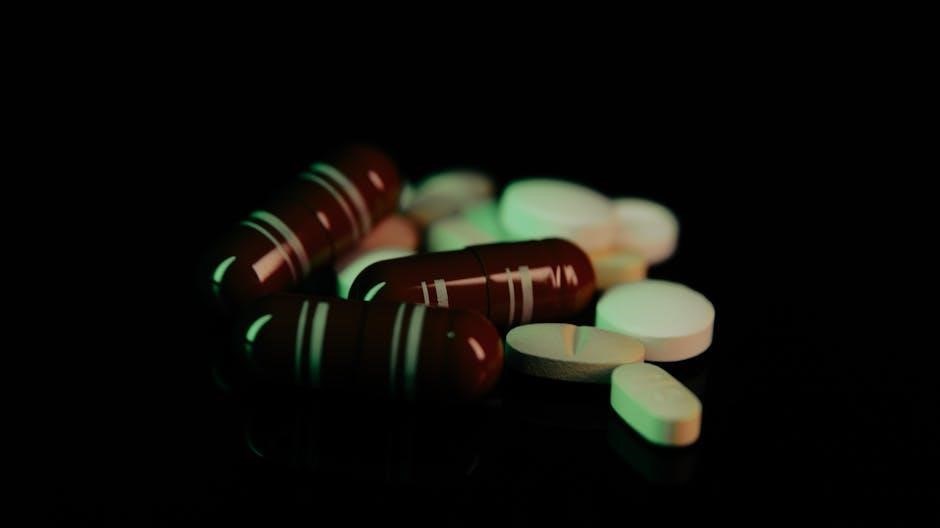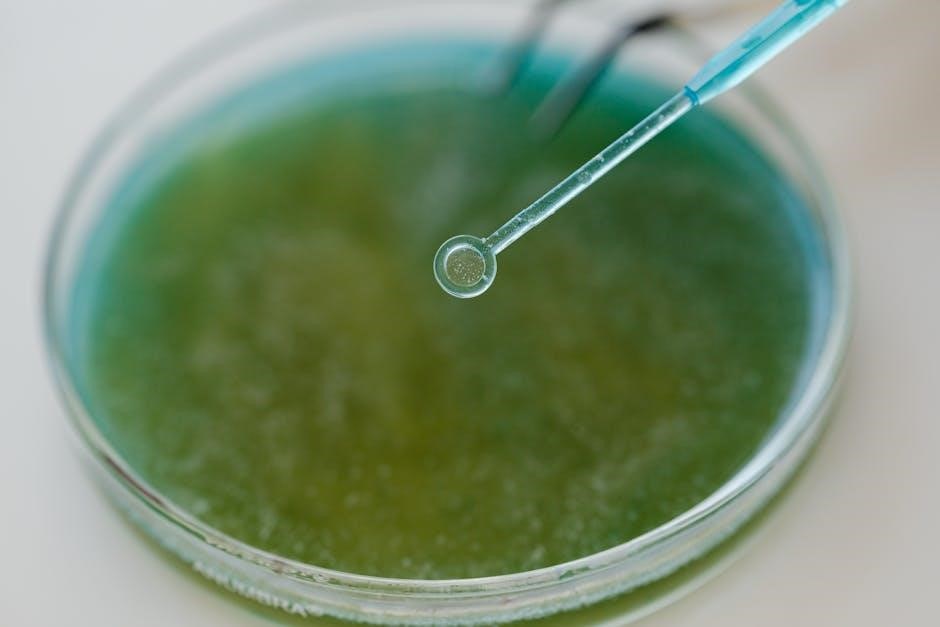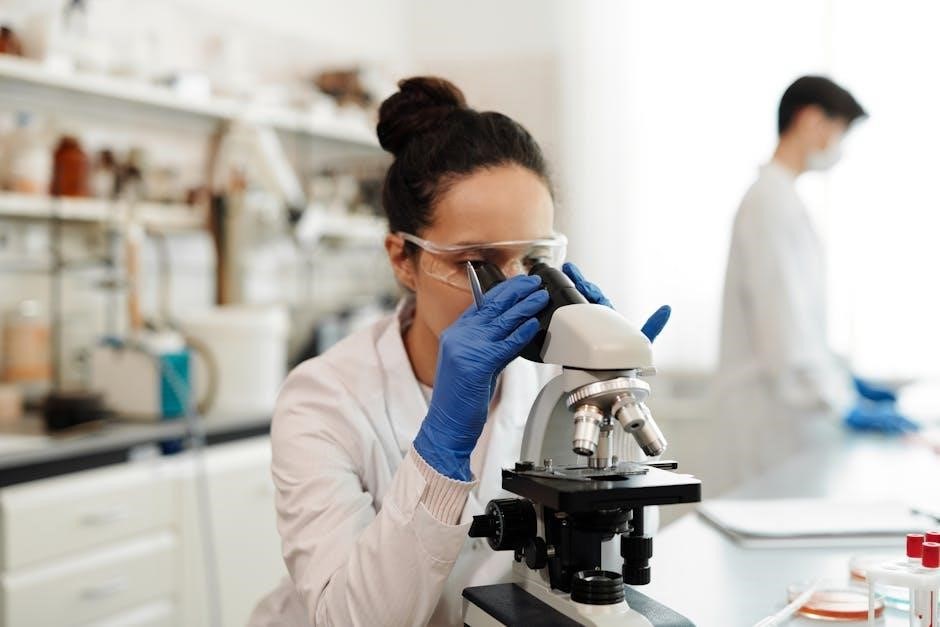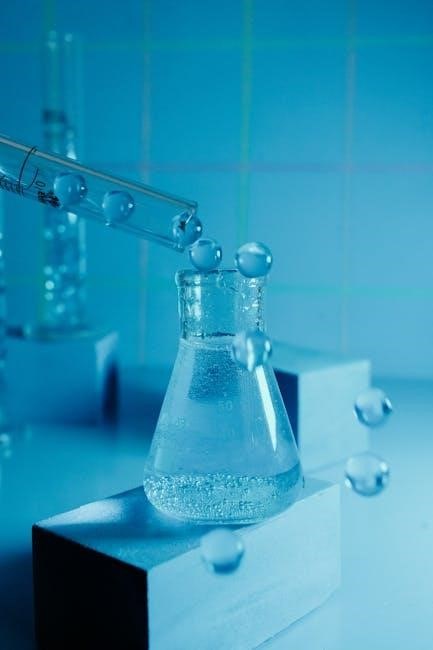Antimicrobial agents are a cornerstone of modern medicine, revolutionizing the treatment of bacterial, viral, and fungal infections. Their discovery has saved countless lives, combating infectious diseases globally.
1.1 Historical Overview of Antimicrobial Medicines
Antimicrobial medicines emerged as a groundbreaking therapeutic advancement in the 20th century, revolutionizing the treatment of infectious diseases. Their introduction fundamentally altered the medical landscape, offering unprecedented hope in combating bacterial, viral, and fungal infections. These agents became a cornerstone of modern medicine, enabling physicians to effectively manage conditions once deemed incurable. The historical development of antimicrobials, from penicillin to modern synthetic compounds, has been pivotal in saving countless lives and shaping global health outcomes.
1.2 The Impact of Antimicrobial Agents on Modern Medicine
Antimicrobial agents have profoundly shaped modern medicine, significantly reducing mortality from infections. Their introduction enabled the treatment of once-fatal diseases, revolutionizing healthcare. They also facilitated advancements in surgery and chemotherapy by preventing infections. The global impact of these agents is immeasurable, underscoring their role as a cornerstone of therapeutic progress. Their continued development remains critical to addressing emerging challenges in infectious diseases.

Mechanisms of Antimicrobial Resistance
Antimicrobial resistance arises through genetic mutations, horizontal gene transfer, or enzymatic modifications, enabling pathogens to evade drug effects and survive treatment.
2.1 Understanding the Development of Resistance in Microorganisms
Resistance in microorganisms emerges through genetic mutations, horizontal gene transfer, or environmental pressures. These adaptations enable pathogens to survive exposure to antimicrobial agents by altering drug targets, enhancing drug efflux, or producing drug-inactivating enzymes. The rise of multi-drug resistant (MDR) bacteria, such as those resistant to penicillin and carbapenems, highlights the urgency of understanding these mechanisms. Such insights are critical for developing targeted therapies and mitigating the spread of resistant infections, which pose a significant global health threat.
2.2 Key Mechanisms of Resistance in Bacteria
Bacteria develop resistance through various mechanisms, including efflux pumps, enzyme production, and target modification. Efflux pumps expel antimicrobial agents, reducing intracellular drug concentration. Enzymes like beta-lactamases degrade antibiotics, such as penicillins and cephalosporins. Target modification involves altering drug-binding sites, as seen in methicillin-resistant Staphylococcus aureus. Horizontal gene transfer spreads resistance genes, accelerating the emergence of multi-drug resistant (MDR) pathogens. These mechanisms highlight the adaptability of bacteria, necessitating innovative strategies to combat resistance and develop effective antimicrobial therapies.

Antimicrobial Susceptibility Testing
Antimicrobial susceptibility testing determines the effectiveness of agents against pathogens, guiding treatment decisions. Methods include broth microdilution and disk diffusion to assess microbial responses to varying drug concentrations.
3.1 Methods for Testing Antimicrobial Activity
Various methods evaluate antimicrobial activity, including broth microdilution, disk diffusion, and Etest. These techniques determine microbial susceptibility by exposing pathogens to varying drug concentrations. Broth microdilution is a standardized method for determining MIC (Minimum Inhibitory Concentration), while disk diffusion assesses zone of inhibition. Etest combines both methods for precise MIC measurement. These protocols are essential for identifying effective antimicrobial agents and guiding therapeutic decisions in clinical settings.
3.2 Minimum Inhibitory Concentration (MIC) Test Protocol
The MIC test measures the lowest concentration of an antimicrobial agent that inhibits microbial growth. The protocol involves preparing serial dilutions of the agent, inoculating with a standard microbial suspension, and incubating. After incubation, the MIC is determined as the lowest concentration showing no visible growth. This method is critical for assessing antimicrobial potency and guiding clinical dosing, ensuring effective treatment while minimizing resistance development. Proper controls and standardized conditions are essential for accurate results.

Synthesis and Development of New Antimicrobial Agents
The development of novel antimicrobial agents involves designing compounds with enhanced potency and selectivity. Researchers utilize chemical synthesis and biological assays to create effective therapies.
4.1 Designing Novel Compounds with Optimized Properties
Designing novel antimicrobial compounds involves optimizing molecular properties for enhanced efficacy and safety. Chemists modify structures to improve target specificity, reducing toxicity and resistance development. Advanced computational tools predict bioactivity, guiding synthesis. Researchers focus on creating compounds with improved pharmacokinetics, ensuring effective drug delivery and bioavailability. This approach accelerates the discovery of potent antimicrobial agents, addressing the growing threat of drug-resistant pathogens. Innovative strategies include incorporating natural product frameworks and leveraging structure-activity relationships.
4.2 Polymer Complexation for Efficient Drug Delivery
Polymer complexation offers a promising strategy for enhancing antimicrobial drug delivery. By encapsulating antimicrobial agents within polymeric nanocarriers, their stability and bioavailability are significantly improved. This method enables controlled release, reducing toxicity and improving efficacy. Polymers like PLGA and PEG are widely used due to their biodegradable and non-toxic properties. such systems can target specific sites of infection, minimizing systemic side effects. This innovative approach addresses challenges in combating resistant pathogens, ensuring sustained therapeutic effects and enhancing patient outcomes in antimicrobial therapy.

Evaluation of Phytochemicals for Antimicrobial Activity
Phytochemicals are natural compounds found in plants, exhibiting potent antimicrobial activity. Their efficacy against bacteria and fungi makes them promising candidates for developing new therapies.
5.1 Phytochemical Investigation of Plant Extracts
Phytochemical investigation involves identifying and characterizing bioactive compounds in plant extracts. These compounds, such as alkaloids and flavonoids, exhibit antimicrobial properties. Advanced techniques like HPLC and NMR are used to isolate and analyze these molecules. Studies focus on plants like Vernonia hymenolepis, showcasing their efficacy against pathogens. This research highlights the potential of natural products in developing novel antimicrobial therapies, addressing the growing issue of drug resistance. The chemical structure of these compounds often correlates with their biological activity, making them valuable candidates for further drug development.
5.2 Efficacy of Natural Products Against Pathogens
Natural products, such as essential oils and plant extracts, have demonstrated significant antimicrobial activity against various pathogens. Studies highlight the potential of compounds like tea tree oil and neem extracts in inhibiting bacterial, fungal, and viral growth. These products often target multiple cellular pathways, reducing the likelihood of resistance development. Their biocompatibility and low toxicity make them promising alternatives to synthetic antimicrobials. Research emphasizes their efficacy in treating infections, showcasing their role in addressing global health challenges effectively.

Future Prospects and Challenges
Advancements in antimicrobial chemistry show promise for combating resistance, but challenges remain in developing effective therapies and addressing rising multi-drug resistance in pathogens.
6.1 Innovations in Antimicrobial Chemistry Research

Recent advancements in antimicrobial chemistry focus on developing novel compounds and delivery systems, such as polymer complexation for nanocarriers, to combat resistant pathogens. Researchers are exploring natural products and phytochemicals for their potential antimicrobial properties. Additionally, innovative methodologies like Raman spectroscopy and late-stage chemical editing of antimicrobial peptides are being investigated. These innovations aim to address the growing challenge of multi-drug resistance while improving drug efficacy and safety.
6.2 Overcoming the Limitations of Current Therapies
Current antimicrobial therapies face challenges such as rising resistance, limited efficacy, and potential toxicity. Innovations like polymer-based nanocarriers and targeted drug delivery systems aim to enhance therapeutic outcomes. Phytochemicals and bioactive compounds from natural sources are being explored for their antimicrobial potential. Additionally, researchers are focusing on developing novel compounds with improved pharmacokinetics and reduced resistance liability. These advancements aim to address the limitations of existing therapies, providing safer and more effective solutions to combat infections.
Antimicrobial agents have revolutionized medicine, but challenges like resistance demand continued research. Natural products and novel compounds offer promising solutions, ensuring future global health advancements and safety.
7.1 The Importance of Continued Research in Antimicrobial Chemistry
Continued research in antimicrobial chemistry is critical to address the growing threat of resistance and develop novel therapies. Innovations in drug design, delivery systems, and natural product exploration are essential. Collaborative efforts between academia and industry can accelerate the discovery of effective agents. Understanding microbial mechanisms and optimizing compound properties ensures sustainable solutions. This research not only combats current challenges but also prepares for future public health crises, safeguarding global health and ensuring the efficacy of antimicrobial treatments for generations to come.
7.2 Potential Contributions to Global Health
Advancements in antimicrobial chemistry hold immense potential to transform global health. Novel agents and therapies could reduce mortality from infectious diseases, particularly in regions with limited healthcare resources. By combating drug-resistant pathogens, these innovations can prevent pandemics and improve quality of life. Phytochemicals and nanocarriers offer sustainable solutions, while targeted therapies minimize side effects. This research not only addresses current health challenges but also fosters a healthier future, ensuring equitable access to life-saving treatments worldwide and promoting global well-being.
